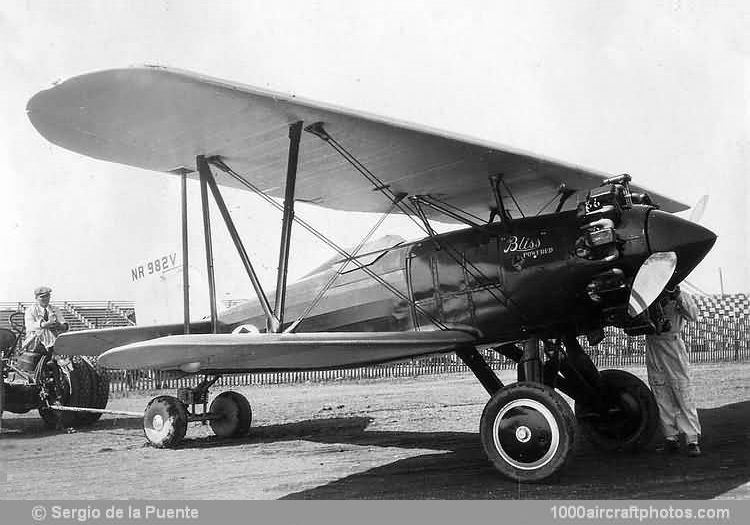02/12/2011. Remarks by Jack McKillop: "Curtiss military aircraft that were exported and/or sold on the civil market originally had no specific designation other than the military designation. In 1930, Curtiss began giving them sequential Hawk type numbers and this Hawk I was a civil version of Curtiss' Model 35, the USAAC's P-6E Hawk.
Powered by a 700 hp Curtiss V-1570-23 Conqueror twelve-cylinder, liquid-cooled V-engine, this aircraft was equipped with extra fuel tanks fitted to the side of the forward fuselage for long distance flights and had a tail skid instead of a tail wheel. To increase stability, the stabilizers and elevators from the USAAC's P-1 Hawks were installed. The aircraft was registered NR636E as a Curtiss Long-Distance Hawk I.
During a test flight, this Hawk I crashed and the aircraft was rebuilt with a 575 hp Wright R-1820 Cyclone nine-cylinder, single row, air-cooled radial engine and redesignated Hawk IA registered NR982V. Alfred 'Al' Williams, a record setting pilot and former Chief Test Pilot for the USN, took delivery of it in August 1930 and had it painted with a red fuselage and struts and silver wings and tail surfaces. Subsequently, the Wright engine was replaced with a 550 hp Bliss Jupiter. (The Bliss Jupiter nine-cylinder single-row air-cooled radial engine was built by the E.W. Bliss Co. of Brooklyn, New York, USA, under license from the Bristol Aeroplane Company in England.)
Williams was a free-lance air show pilot who would finish his act with a dive on a small shack and drop military practice bombs to detonate black powder charges. In early 1931, the engine failed and Williams crashed in Charlotte, North Carolina. The airplane was rebuilt, the Jupiter engine was replaced by a 700 hp Wright Cyclone engine and the fabric covering was replaced by a faired aluminum skin.
In 1933, Williams negotiated a deal with the Gulf Oil Company to start an aviation department with him as head of it. The aircraft was repainted a bright orange, named "Gulfhawk" and flown on the air show circuit until 1936 when Williams replaced it with the Grumman Model G-22 "Gulfhawk II".
The history of this aircraft is unknown until it was discovered at the Aviation Trade School in New York City. Hollywood stunt pilot Frank Tallman purchased it from Williams in 1958 and moved the Hawk to California for restoration. It took four years to restore the rudder, rudder pedals, elevators, instruments, throttle quadrant and most of the metal skin panels. A 600 hp Pratt & Whitney Wasp R-1340 nine-cylinder single-row air-cooled radial engine from a surplus North American AT-6/SNJ Texan was installed along with a variable pitch Hamilton Standard propeller. Tallman made the first flight in the restored aircraft in 1962 and flew it in air shows. When not flying, the aircraft was displayed at the Tallmantz Movieland of the Air Museum in Anaheim, California.
In 1966, the aircraft was sold to an auto company in Omaha, Nebraska. Legal action followed because the 1958 purchase agreement between Williams and Tallman included the understanding that Tallman would eventually donate the "Gulfhawk" to the NASM in Washington, District of Columbia. The Nebraska auto company put the machine up for auction in 1968 and the gentleman who bought it donated it to the NASM in August 1969. The plane was loaned to the Overton Wings and Wheels Museum in Mullen, South Carolina until it was returned to the NASM's Garber Facility in Suitland, Maryland in August 1982.
This famous aircraft was on display at NASM's storage facility, currently it is at NASM's Stephen F. Udvar-Hazy Center in Chantilly, Virginia."
